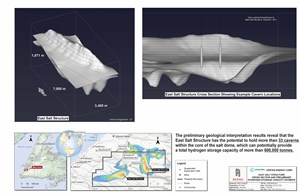News
Vortex Energy announces large-scale H2 storage estimates at the Robinsons River Salt Project
Vortex Energy announced the completion of a H2 storage capacity assessment for the East and West Salt Structures at the Robinsons River Salt Project. The work was completed by the company’s contracted consultant partner, RESPEC Consulting Inc., a global leader in geology, geophysical and engineering work with direct experience in underground H2 storage caverns.
Highlights
- East Salt Structure: Based on available geological information, the East Salt Structure can potentially hold an estimated amount of 550,000 tons of H2 in more than 35 caverns, based on conservative estimates and up to 900,000 tons of H2 in more than 53 caverns, using optimistic estimates. Using conservative estimates, the H2 storage capacity assessment for the East Salt Structure estimates that the total volume of the East Structure salt cavern field is more than 70 MMm3.
- West Salt Structure: Based on the available geological information, the West Salt Structure can potentially hold an estimated amount of 250,000 tons of H2 in more than 25 caverns, based on conservative estimates and up to 350,000 tons of H2 in more than 43 caverns, using optimistic estimates. Using conservative estimates, the H2 storage capacity assessment for the West Salt Structure estimates that the total volume of the West Structure salt cavern field is more than 50 MMm3.
H2 storage capacity assessment. To conduct the H2 storage capacity assessment, RESPEC generated preliminary cavern layouts and performed high-level thermodynamic calculations to estimate the H2 storage capacity of the East and West Salt Structures based on the interpreted geology, operating pressure limits set by the Canadian Standards Association Z341, and the estimated cavern dimensions based on the Company’s gravity and 2D seismic interpretation of the salt dome structure at the Project.
Because the 2D seismic interpretation results on which the H2 storage capacity assessment is based decrease in accuracy with increased distance from the seismic lines, RESPEC generated conservative and optimistic cavern field layouts based on the distance from the seismic lines and distance from the salt dome core. The conservative case only considers salt caverns closer to the seismic lines and within the salt dome core whereas the optimistic case also includes caverns away from the core of the salt dome.
The placement and design of any salt caverns that are ultimately developed by the company at the project will be dependent on the local geology and the thickness of salt strata at the cavern well location. In generating the cavern field layout for the H2 storage capacity assessment, RESPEC assumed that caverns were placed at a spacing-to-diameter ratio of 4, at least 1.5 cavern diameter length away from the salt dome boundary, limited in diameter to 80 meters and located at least 200 m below the top of salt and 200 m away from the bottom of salt.
Paul Sparkes, Chief Executive Officer of Vortex said, “These preliminary results from RESPEC are very promising. If the results of the assessment are accurate, the Project has the potential to store significant amounts of H2 and could end up being one of the largest salt cavern discoveries on the east coast of Canada. We believe that these results, along with our recent agreement to acquire additional land to the north of the Project, position Vortex to capitalize on the growing demand for H2 and other renewable energy infrastructure.”



